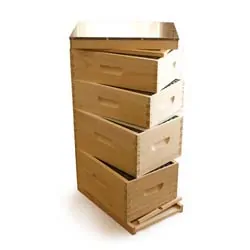Worker bees are sterile and may not be able to lay eggs like a queen bee can, nor do they play much of a role in the reproduction of bees like drones, but they do handle nearly ALL other tasks that are required of bees, both inside and out of the beehive.
Worker bees have various jobs throughout their lifetime, all dependent on their age. Young worker bees will help with things like feeding “bee bread” to developing brood within cells in the brood nest, making and using wax to build comb, and caring for newly hatched bees. Older workers handle high-risk tasks, such as foraging for resources, communicating with buzzing and the “Waggle Dance” to indicate sources of pollen or nectar, maintaining optimal hive conditions, and more.
Despite its fatal effect on them, worker bees guarding the entrance may sometimes sting intruders like wasps or honeybees from other colonies to protect the colony. Workers may team up to form a ball of bees surrounding a wasp or other intruder that found its way inside, vibrating their flight muscles to enough heat (up to 115 degrees F!) to neutralize the threat.
A very important task for worker bees is to regulate the hive’s environment and ensure it stays at the ideal temperature. Worker bees will ‘fan’ the air around by flapping their wings to aid in airflow and ventilation and to help remove moisture from nectar. They must work together to do this, especially when there is a lot of moisture inside the hive. When temperatures are extremely cold in the winter months, specialized worker bees called “winter bees” will form a tight cluster around the queen to keep her and the rest of the colony safe until spring and warmer weather arrive.
Read More
Exploring the Process of Pollination (and the Waggle Dance)
The Role of the Worker Honeybee *
Why and How Honeybees Forage *
How Bees Manage Temperature and Moisture *
* Colony Member-Only Content
